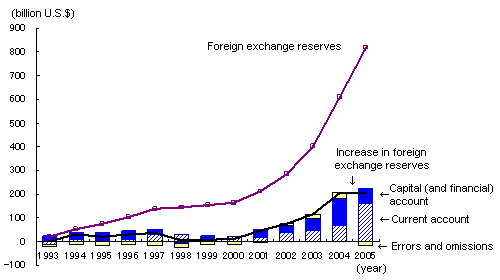As symbolized by the surge in China's foreign exchange reserves, the Chinese currency has been under upward pressure in recent years. The situation has remained virtually unchanged even after China revalued the yuan by 2.1% on July 21, 2005 and shifted to a managed float system. As a result, China's foreign exchange reserves finally came to top those of Japan in February 2006 to become the largest in the world. China is trying to ease upward pressure on the yuan through such means as controlling exports and encouraging imports and capital outflows, but they have yet to bear fruit, and a further appreciation of the yuan is unavoidable.
The backdrop for the surge in China's foreign exchange reserves is that both its current account, centering on trade, and its capital account, which centers on direct investment, are logging huge surpluses. The relationship between the sharp rise in China's foreign exchange reserves and its "twin surpluses" in its external accounts can be confirmed in the "2005 Report on China's Balance of Payments" (State Administration of Foreign Exchange) released in April ( diagram ). According to the report, the current and capital account surpluses in 2005 stood at $160.8 billion (7.2% of gross domestic product) and $63 billion (2.8%), respectively. Together with the $16.8 billion logged as a deficit of statistical discrepancies, reserve assets (which are mostly foreign exchange reserves) increased by some $207.0 billion in 2005, after rising by $206.4 billion the previous year.
The increase in the nation's foreign exchange reserves in 2005 was virtually unchanged from that in 2004. But while the current account surplus increased 134% compared to the $68.7 billion logged the previous year, the capital account surplus was 43% less than the $110.7 billion registered in 2004, and the current account surplus replaced the capital account surplus as the greatest factor behind the increase in foreign exchange reserves. As a result, it is no longer convincing to oppose a revaluation of the yuan on the grounds that upward pressure on the currency is the result of "speculation" in the form of capital inflow rather than "actual demand" base on current transactions.
As the latest "Report on China's Balance of Payments" also points out, condoning a huge surplus in the balance of payments has negative impacts on the macroeconomy. First, it leads to a continued rise in the export of goods that require the input of a huge amount of resources and thus harm the environment, and delays the transition from an "extensive" growth model based on the expansion of inputs to an "intensive" growth model based on productivity increase. Second, the jump in trade imbalances and foreign exchange reserves is aggravating trade friction with China's trading partners. Third, the increase in foreign exchange reserves is exacerbating an investment overheat and a rise in asset prices through an increase in money supply.
In order to correct these imbalances, Chinese authorities have taken steps to increase demand for foreign currency while at the same time limiting its supply. First, as for current transactions, they have imposed export restraints on such goods as steel and petroleum products that require a huge input of resources and lead to environmental degradation, and certain textile products that have become the focus of trade frictions. Meanwhile, ahead of President Hu Jintao's April visit to the United States, Vice Premier Wu Yi led a huge business delegation to the U.S. and signed purchasing contracts worth some $16 billion with U.S. firms, including a deal with major aircraft manufacturer Boeing to buy eighty 737 jumbo jets (worth $4.6 billion). As for capital transactions, authorities have eased restrictions on capital outflow, which in the past had been stricter than those on capital inflow. Specifically, the government has introduced the qualified domestic institutional investor (QDII) system and will use it to encourage portfolio investment in overseas markets. However, not only are the effects of such policies limited, they are only stopgap measures, and do not lead to the resolution of the problem.
The fundamental cause of China's huge external surplus is that authorities try to maintain the yuan's exchange rate at a lower level through market intervention. If a free float exchange rate system were to be adopted and authorities did not intervene in the foreign exchange market, there would be no external account imbalances, and instead of a rise in foreign exchange reserves, China would see the yuan appreciate against the dollar. In this sense, allowing the exchange rate to appreciate to its "equilibrium level" is the most effective way to correct external account imbalances. However, due to concerns about a possible negative impact on the domestic economy as well as its position that it "cannot cave in to external pressure," the Chinese government remains cautious about letting the yuan to appreciate at a faster pace. On May 15, the yuan's exchange rate broke through the 8 yuan per dollar level for the first time since its shift to a managed float system, but the cumulative appreciation so far is still a scant 1.4%.
In response to this situation, the U.S., while refraining from designating China an "exchange rate manipulator" in the Treasury Department's latest bi-annual "Report on International Economic and Exchange Rate Policies," (released May 10) expressed "strong disappointment" with the delay in yuan reforms and called on Beijing to accelerate them. However, at the same time, the report also clearly says that "we are not asking China for an immediate full float of the currency with full liberalization of controls on capital movements." When the positions of both China and the U.S. are considered together, accelerating the pace at which the yuan rises to about 3%-4% per year is probably the minimum cost necessary to continue to avoid being designated an "exchange rate manipulator" and gain time to implement adjustments.

(Source)State Administration of Foreign Exchange of China


